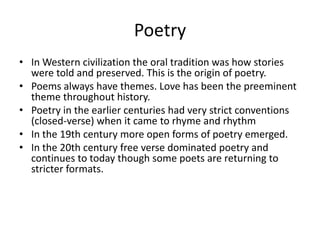
Poetry and Fiction PPT
- 1. Poetry • In Western civilization the oral tradition was how stories were told and preserved. This is the origin of poetry. • Poems always have themes. Love has been the preeminent theme throughout history. • Poetry in the earlier centuries had very strict conventions (closed-verse) when it came to rhyme and rhythm • In the 19th century more open forms of poetry emerged. • In the 20th century free verse dominated poetry and continues to today though some poets are returning to stricter formats.
- 2. Scansion • Scansion is the act of scanning a line of poetry • Each unit of stressed and unstressed syllable is a foot • The meter (formal rhythm) of a poem is signaled by the type of foot it employs and the number of feet in each line: 4 (tetrameter), 5 (pentameter), 6 (hexameter), 7 (heptameter) feet are the most common • Most poems employ a single meter throughout with specific feet to create emphasis • Scansion is relevant in the analysis of poems of a certain genre, by a specific author, from a certain time period as it is a way of identifying a pattern within a work (as discussed in the last lesson about Critical Reading)
- 3. Poetic Rhymes • Seen often in closed-verse • Emerged in the Middle Ages. Latin and Greek were based on meter. • End-rhyme is what we see most often in poems and songs • Masculine rhyme – Final syllables of an exact rhyme are stressed and identical – Short and Sort – Long and Throng • Feminine rhyme – Unstressed syllable rhyming with stressed syllable – Explicit and Visit • Triple rhyme – Final three syllables are identical – Merrily and Verily • Half or off-rhyme – Only final consonant rhymes exactly – Ill able and Syllable
- 4. Other Poetic Rhymes • Eye rhyme – Appears to rhyme based on spelling but pronounced differently – Plow and Blow • Internal rhyme – Two words in a line rhyming – I went home to find my comb • Alliteration – Repetition of initial sounds – Amazing America – Incredible India – Always asleep • Assonance – Repetition of vowel sounds followed by different consonants – Coop, comb • Consonance – Repetition of consonant sound with different vowel sound – Come to my arms my beamish boys
- 5. Unrhymed Forms • Blank verse – epic poetry, mirrors the pattern of natural speech • Haiku, Tanka, Japanese poetry – determined solely by syllables • Free verse – enormous range of choice • Prose poem – visual appearance of prose but has poetic aspects
- 6. Analyzing Poetry • Poetic rhythm is identified by the meter of the lines • Structure of stanzas (groupings of lines) • Parse sentences of poem • Analyze adherence of diversion from poetic convention • Meter has a more subliminal effect affecting our feelings towards the tone of a poem • Rhyme and repetition can be more obvious and overt in their aesthetic and oral effect
- 7. Fiction • Artistic depiction of facts that may be real or completely imagined. • Classified by Genre (science fiction, romance) and by Length (novel, short story) • Common forms of fiction – Short Story – Novella – Novel
- 8. Elements of Fiction • Plot – Events which occur, motivation and driving force of the story • Character • Narration – Reliable Narrator – Unreliable Narrator – Different Points of View • First Person • Second Person • Third Person • Setting – Time period – Physical location and environment
- 9. Diction/Word Choice • Exercise – Asked vs. Interrogated – Existence vs. Life – Said vs. Declared – Dad vs. Father • Meaning and context – Father instead of Dad in a fight scene – what would that indicate?